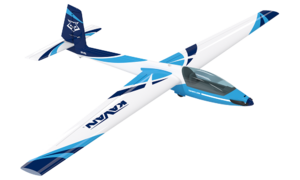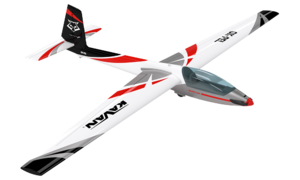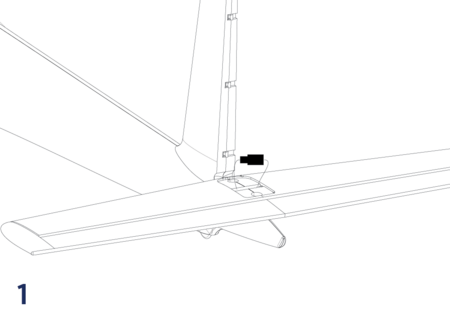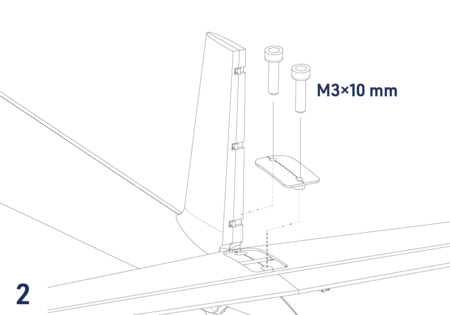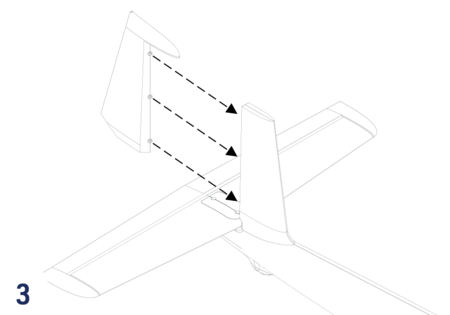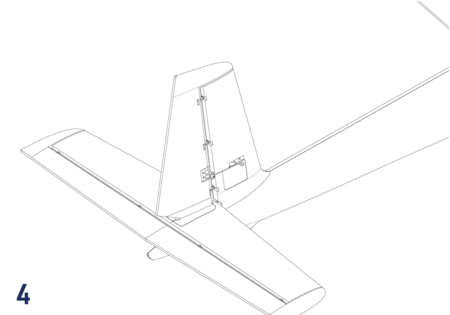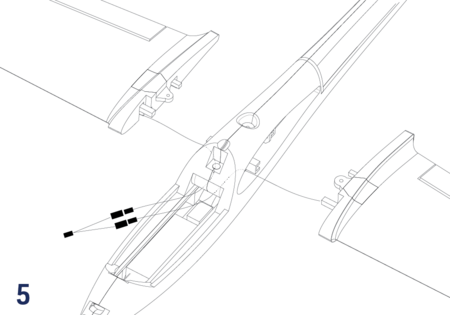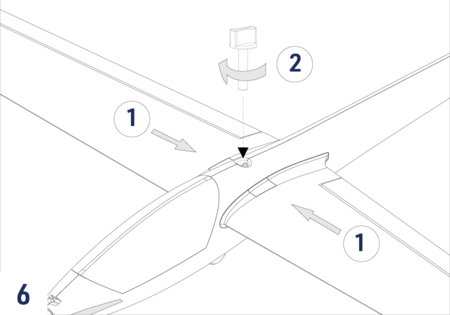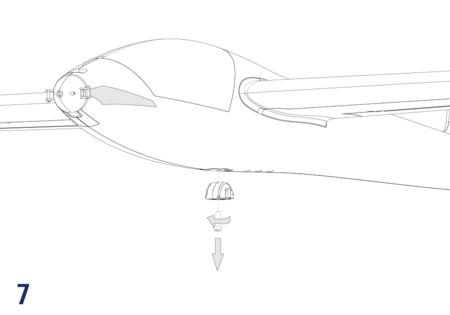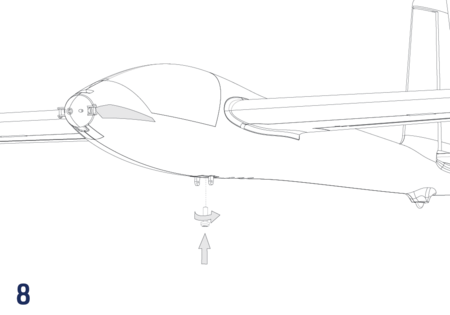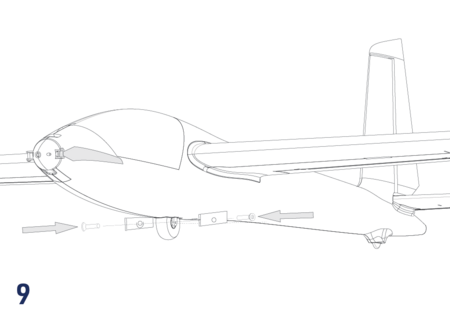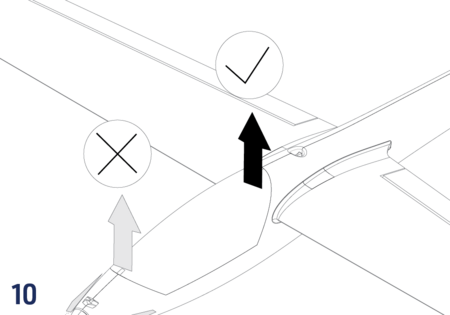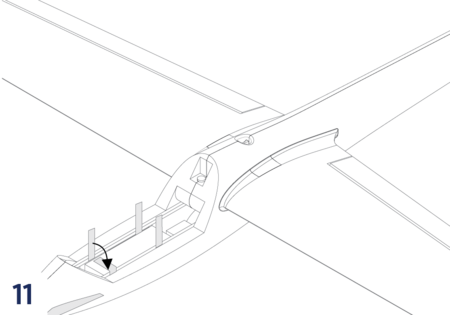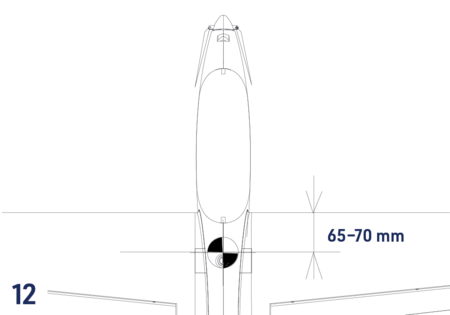KAVAN Swift S-1 - Manuel d'instructions
Introduction
Félicitations pour l'achat de votre modčle semi-maquette du planeur acrobatique Swift S-1 ! Vous allez commencer l'assemblage d'un modčle fabriqué en mousse EPO (polyoléfine expansée) quasiment incassable, propulsé par un puissant moteur brushless et une batterie LiPo légčre. Tous ceux qui ont déjŕ maîtrisé le vol d'un "trainer complet" – avec aileron, profondeur, direction et contrôle des gaz – apprécieront ce magnifique planeur de haute performance.
Swift S–1: un champion Polonais de voltige aérienne
Ŕ la fin des années 1980, les usines aéronautiques Marganski & Myslowski ont constaté qu'il y avait une « lacune » sur le marché des planeurs de voltige : il semblerait que le bon vieux SZD–21–2b Kobuz 3 en bois, conçu dans les années 1950, n'était plus ŕ la mode. Ainsi, en 1991, les concepteurs Edward Marganski et Jerzy Cisowski, soutenus par Jerzy Makula (alors triple champion du monde de voltige en planeur), ont présenté le Swift S–1, un planeur de voltige moderne entičrement composite, avec un incroyable taux de roulis de 4 secondes, capable de supporter des charges allant jusqu'ŕ +/-10g. La récompense ne s'est pas fait attendre : Jerzy Makula a remporté son quatričme championnat du monde de voltige en planeur FAI la męme année !
Avant de commencer
- Si vous n'ętes pas un pilote RC expérimenté, prévoyez de faire vérifier votre modčle terminé par un pilote compétent qui pourra vous aider lors de vos premiers vols. Męme si nous avons tenté de vous fournir un manuel d'instructions complet, les modčles RC sont assez complexes, et un modéliste expérimenté peut rapidement passer en revue votre modčle pour s'assurer que vos premiers vols seront un succčs.
- Veuillez assembler votre modčle exactement selon ces instructions. Ne tentez pas de modifier ou de changer votre modčle de quelque maničre que ce soit, car cela pourrait altérer ses caractéristiques de vol.
- Avant de commencer, veuillez vérifier l'intégralité du contenu de ce kit pour vous assurer qu'aucune pičce n'est manquante ou endommagée. Cela vous aidera également ŕ vous familiariser avec chaque composant de votre avion. Si vous constatez qu'une des pičces est manquante ou endommagée, veuillez contacter immédiatement votre revendeur pour obtenir un remplacement.
- Effectuez un montage ŕ blanc de chaque pičce avant de la coller en place. Assurez-vous d'utiliser la bonne pičce et qu'elle s'ajuste correctement avant l'assemblage. Un bon ajustement est essentiel, car aucune colle ne pourra corriger un mauvais montage !
- Le manuel comprend un schéma indiquant la position par défaut du Centre de Gravité (CG) ainsi que les débattements recommandés des gouvernes. Il est crucial de respecter la position du CG recommandée pour le premier vol, sinon le modčle pourrait devenir instable, difficile ŕ contrôler, voire incapable de voler ! Par la suite, vous pourrez ajuster la position du CG pour l'adapter ŕ votre style de vol et ŕ vos compétences.
Précautions
Ce modčle RC n'est pas un jouet. Manipulez-le avec soin et suivez strictement les instructions de ce manuel.
Assemblez ce modčle en suivant strictement ces instructions. NE PAS modifier NI altérer le modčle. Si vous ne respectez pas ces consignes, la garantie sera annulée automatiquement. Suivez les instructions pour obtenir un modčle sűr et solide ŕ l'issue du montage.
Les enfants de moins de 14 ans doivent faire fonctionner le modčle sous la supervision d'un adulte.
Assurez-vous que le modčle est en parfait état avant chaque vol, en veillant ŕ ce que tout l'équipement fonctionne correctement et que la structure du modčle ne soit pas endommagée.
Volez uniquement par temps calme et dans un endroit sűr, loin de tout obstacle.
Précautions de sécurité et avertissements
- Un avion RC n'est pas un jouet ! En cas de mauvaise utilisation, il peut causer de graves blessures corporelles et endommager des biens. Volez uniquement dans un endroit sűr en suivant toutes les instructions et recommandations de ce manuel. Faites attention ŕ l'hélice ! Gardez les objets susceptibles de s'enchevętrer dans l'hélice loin de celle-ci lorsqu'elle tourne, y compris les vętements amples ou d'autres objets comme des crayons et des tournevis. Assurez-vous que vos mains et celles des autres ainsi que leurs visages restent éloignés de l'hélice en rotation.
- En tant qu'utilisateur de ce produit, vous ętes seul responsable de son utilisation de maničre ŕ ne pas mettre en danger votre sécurité, celle des autres ou ŕ ne pas endommager le produit ou les biens d'autrui. Ce modčle est contrôlé par un signal radio, qui peut ętre soumis ŕ des interférences provenant de nombreuses sources échappant ŕ votre contrôle. Ces interférences peuvent entraîner une perte momentanée du contrôle, il est donc conseillé de toujours maintenir une distance de sécurité dans toutes les directions autour de votre modčle, cette marge vous aidant ŕ éviter les collisions ou les blessures.
- Ne jamais faire fonctionner votre modčle avec des batteries de l'émetteur déchargées.
- Toujours faire fonctionner votre modčle dans une zone ouverte, loin des lignes électriques, des voitures, de la circulation ou des personnes. Évitez de faire voler votre modčle dans des zones peuplées oů des blessures ou des dommages pourraient survenir.
- Suivez attentivement les instructions et les avertissements concernant ce modčle ainsi que pour tout le matériel de support optionnel (chargeurs, batteries rechargeables, etc.) que vous utilisez.
- Gardez tous les produits chimiques, petites pičces et tout élément électrique hors de la portée des enfants.
- L'humidité cause des dommages aux équipements électroniques. Évitez toute exposition ŕ l'eau pour tout matériel qui n'est pas spécifiquement conçu et protégé ŕ cet effet.
- Le modčle est principalement constitué de plastiques – il n'est pas ignifuge. Il ne doit pas ętre exposé ŕ des températures élevées, sinon une déformation sévčre de la structure en mousse ou d'autres dommages peuvent survenir.
Caractéristiques
| Envergure | 2405mm |
| Longueur | 1300mm |
| Surface alaire | 45dm² |
| Poids | 1800g |
| Poids total | 2000–2050g |
| Moteur | C3548-750 |
| ESC | KAVAN R–50SB SBEC |
| Hélice | 11×8" |
Set contents
- Almost ready-to-fly model of a sailplane with the brushless motor, speed controller and servos installed, instruction manual.
You will also need
- At least 7-channel RC set, 14.8 V 2200–2700 mAh LiPo flight pack.
- Regular modeller’s tools – modeller‘s knife (KAV66.770), screwdrivers, pliers etc.
Model assembly
- Connect the elevator servo cable to the corresponding extension cable in the fuselage. Use a shrinking tube or strip of sticky tape to secure the connectors from disconnecting during flight. (Fig. 1)
- Secure the horizontal stabilizer with two M3×10 mm screws. (Fig. 2)
- Attach the rudder to the fin and snap the rudder hinges in place. (Fig. 3)
- Connect the rudder servo linkage to the rudder arm. (Fig. 4)
- Connect the aileron servo cables to the corresponding extension cables in the wing opening in the fuselage. (Fig. 5)
- Insert the wing halves into the fuselage and secure with the M6 nylon bolt. (Fig. 6) Your Swift S1 is fitted for the belly landing as supplied; you might wish to add the undercarriage.
- Remove the screw and the foam filler from the landing wheel bay. (Fig. 7)
- Install the wheel yoke using the same screw into the wheel bay. (Fig. 8)
- Insert the wheel into the yoke, attach the dummy undercarriage doors from both sides of the yoke and secure with two screws. (Fig. 9)
- The flight pack is to be placed in the bay in the centre of the cockpit; use Hook–and–loop ties to fasten it. You can place your receiver (secured with a strip of Hook–and–loop or double-sided foam tape) behind the flight pack; the ESC is to be secured by the same along the flight pack. Connect servos and your ESC to the receiver; deploy the antennas so their active parts are square to each other (if you are using a receiver featuring diversity antennas). With your radio on, set the servos to the neutral position (sticks and trims centred) and fasten the setting screws of the pushrod connectors on the elevator and rudder servo arms. Perform the throttle range calibration of the ESC as described in the attachment of this manual. (Fig. 10+11)
- Attach the canopy.
RC set installation and preflight check
- Referring to the instruction manual of your radio carefully hook up the onboard electronics.
- Once everything has been correctly connected, turn on your transmitter and plug in the flight pack. Check the neutral positions and throws of all control surfaces. If you need to make the control surface throws smaller, simply move the pushrod closer to the centre on the servo arm or move it far from the control surface on the control horn. And vice versa.
| Low rate | High rate | |
| Ailerons | 10 mm up/5 mm down | 15 mm up/8 mm down |
| Ailerons (Airbrake) | 22 mm up | 22 mm up |
| Elevator | ± 10 mm | ± 15 mm |
| Elevator (Airbrake) | 3 mm up | 3 mm up |
| Rudder | ± 25 mm | ± 35 mm |
- The "Low Rate" recommended control surface throws are suitable for a less skilled pilot and regular soaring. The "High Rate" setting allows an experienced pilot to explore the full capabilities of his model. The aileron differential (aileron down deflection reduced to 50 % of up deflection) is only possible with a computer radio.
- Check the direction of rotation of the propeller. If it is incorrect, simply swap any two of the three wires between the ESC and motor or program the ESC (refer to the ESC manual).
- Check the correct position of the centre of gravity (CG): 65–70 mm behind the leading edge of the wing (Fig. 12). Adjust the CG position by moving the flight pack – if you cannot reach the recommended position, do not hesitate to add an appropriate amount of lead to the nose or tail. An extra couple of grams won’t spoil the flying characteristics - but the incorrect CG position is a killer.
- Fully charge your flight pack and transmitter batteries, check the proper function of your radio and perform the range check of your radio according to its instruction manual. The range has to be almost the same with the motor off and at full throttle (no more than a 10 % decrease is acceptable). DO NOT try to fly unless the range check is 100% successful.
Flying
The test-flying and fine-tuning are pretty much straightforward, there will be no surprise for a medium-advanced pilot who is supposed to fly this model.
Appendix
KAVAN R-50SB instructions
Please refer to the KAVAN ESCs - Instruction manual.
Recycling and Waste Disposal Note (European Union)

Electrical equipment marked with the crossed-out waste bin symbol must not be discarded in the domestic waste; it should be disposed of via the appropriate specialised disposal system. In the countries of the EU (European Union) electrical devices must not be discarded via the normal domestic waste system (WEEE - Waste of Electrical and Electronic Equipment, Directive 2012/19/EU). You can take your unwanted equipment to your nearest public collection point or recycling centre, where it will be disposed of in the proper manner at no charge to you. By disposing of your old equipment in a responsible manner you make an important contribution to the safeguarding of the environment!
EU Declaration of Conformity (European Union)

Hereby, KAVAN Europe s.r.o. declares that the model Swift S-1 model and the included electronic and electric devices are in compliance with the requirements of relevant European directives and harmonized norms. The full text of the Declaration of Conformity is available at www.kavanrc.com/doc/.
Guarantee
The KAVAN Europe s.r.o. products are covered by a guarantee that fulfils the currently valid legal requirements in your country. If you wish to make a claim under guarantee, please contact the retailer from whom you first purchased the equipment. The guarantee does not cover faults which were caused in the following ways: crashes, improper use, incorrect connection, reversed polarity, maintenance work carried out late, incorrectly or not at all, or by unauthorised personnel, use of other than genuine KAVAN Europe s.r.o. accessories, modifications or repairs which were not carried out by KAVAN Europe s.r.o. or an authorised KAVAN Europe s.r.o., accidental or deliberate damage, defects caused by normal wear and tear, operation outside the Specification, or in conjunction with equipment made by other manufacturers. Please be sure to read the appropriate information sheets in the product documentation.
